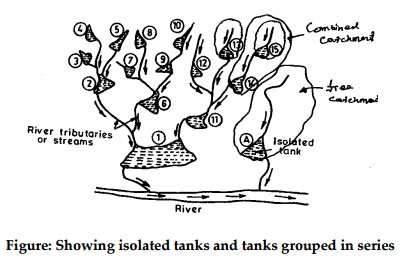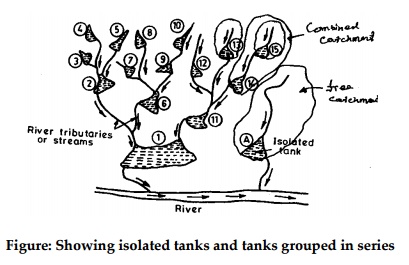Chapter: Civil : Water Resources and Irrigation Engineering : Diversion and Impounding Structures
Isolated Tanks and Tanks in Series

Tank Irrigation
Definition and General Introduction
Tank
irrigation may be defined as the storage irrigation scheme, which utilizes the
water stored on the upstream side of a smaller earth dam, called a bund. These
earthen bund reservoirs are, thus, infact, called as tanks, specifically in
South India, where such works are very common. This terminology is, therefore,
limited to India only.
There is,
thus, no technical difference betw-sized tank will be termed as a reservoir.
Moreover, a reservoir will generally be formed by dams of any material (such as
masonry dam, concrete dam, or earth dam, etc.); whereas, a tank is generally
said to be formed by earth dams only (or strictly speaking by earthen bunds).
These earthen bunds, spanning across the streams, are called tank bunds or tank
bands.
Most of
the existing tanks of south India possess a maximum depth of 4.5 m, while a few
are as deep as 7.5 to 9 m, and only a few exceptional ones exceed 11 m in
depth. When the depth of the tank exceeds 12 m or so, the tank is generally
referred to as a reservoir.
Like all
earth dams, tank bunds are generally provided with sluices or outlets for
discharging water from the tank for irrigation or other purposes. These tank
sluices may be pipes or rectangular or arched openings passing near the base of
the bund and through the body of the bund, and carrying the water into the
downstream channel below the bund or transporting at distances where required,
through pipes or canals. Sometimes, the supply sluices may not be passed
through the body of the bund, and may be carried adjacent to it through some
hill side at one end of the bund.
Similarly,
as in the case of all dam reservoir projects, tanks are provided with
arrangements for spilling away the excess surplus water that may enter into the
tank, so as to avoid over-topping of the tank bund. These surplus escape
arrangements may be in the form of a surplus escape weir, provided in the body
or at one end of the tank body, or some other arrangement like a siphon
spillway may be provided as is done in the case of earth dam projects. The
surplus escape weir is a masonry weir (compared to an ogee spillway in an earth
dam) with its top i.e. crest level at equal to Full tank level (F.T.L.). When
tank is full up to FTL, and extra water comes in, it is discharged over the
surplus escape weir. The length or capacity of this surplus escape weir will be
so designed that water level in the tank does never exceed the maximum water
level (M.W.L). The top of the tank bund will be kept at a level, so as to
provided a suitable free-board above this M.W.L.
Since the
surplus escape weir is a masonry weir, it will have to be properly connected to
the earthen bund by suitably designed bank connections.
Isolated Tanks and Tanks in Series
Most of
the existing small sized tanks of south India form part of groups of tanks,
which are connected together in series, such that any tank either receives the
surplus water of the upper tank(s), or sends its own surplus into some lower
tank(s), or do both. However, when a tank neither receives water from an upper
tank nor discharges its own surplus into a lower tank, it is called an isolated
tank. There do exist some isolated tanks also in south India.
Figure
shows typical group of 15 and an isolated tank A. It is evident that
considerable economy of water can be obtained from the system of grouping,
because the surplus water of the each tank and also the drainage of its wet
cultivation are caught up by the next lower tank. Each tank of the group takes
a share in the yield of the whole catchment above it, which can be classified
as follows:
(i)
the
free catchment, which is the catchment area which only drains into the tank
under consideration ; and
The combined catchment, which is the area of the
whole catchment above the tank under consideration.

Figure: Showing isolated tanks and
tanks grouped in series
The
difference between the combined and the free catchment, thus, gives the area of
catchment intercepted by upper tanks. The whole catchment of the highest tank,
on each drainage, shall be its free catchment. Moreover, each tank will receive
the whole run-off from its free catchment; but from the remainder of its
catchment it will receive only the balance runoff which remains after the upper
tanks have been filled.
One of the disadvantages of grouping of tanks,
however, is that, if a breach occurs in an upper tank, it exposes all the tanks
in the series below, to the risk of similar failures. Hence, while making
repairs or doing restoration works in such groups of tanks, it is necessary to
consider each system of tanks collectively as a whole, and to carry out repairs
from the upper end of each group. The extent of danger to lower tanks due to
breach of an upper tank, however, deperds upon their relative capacities. For
example, if a small upper tank breaches and passes its storage into lower
large-capacity tank, it may pose little danger even if the breach may
completely empty the small tank. How ever, the danger will be imminent if the
case is opposite, and the large sized upper tank breaches and passes its
storage into the lower small sized tank.
Related Topics